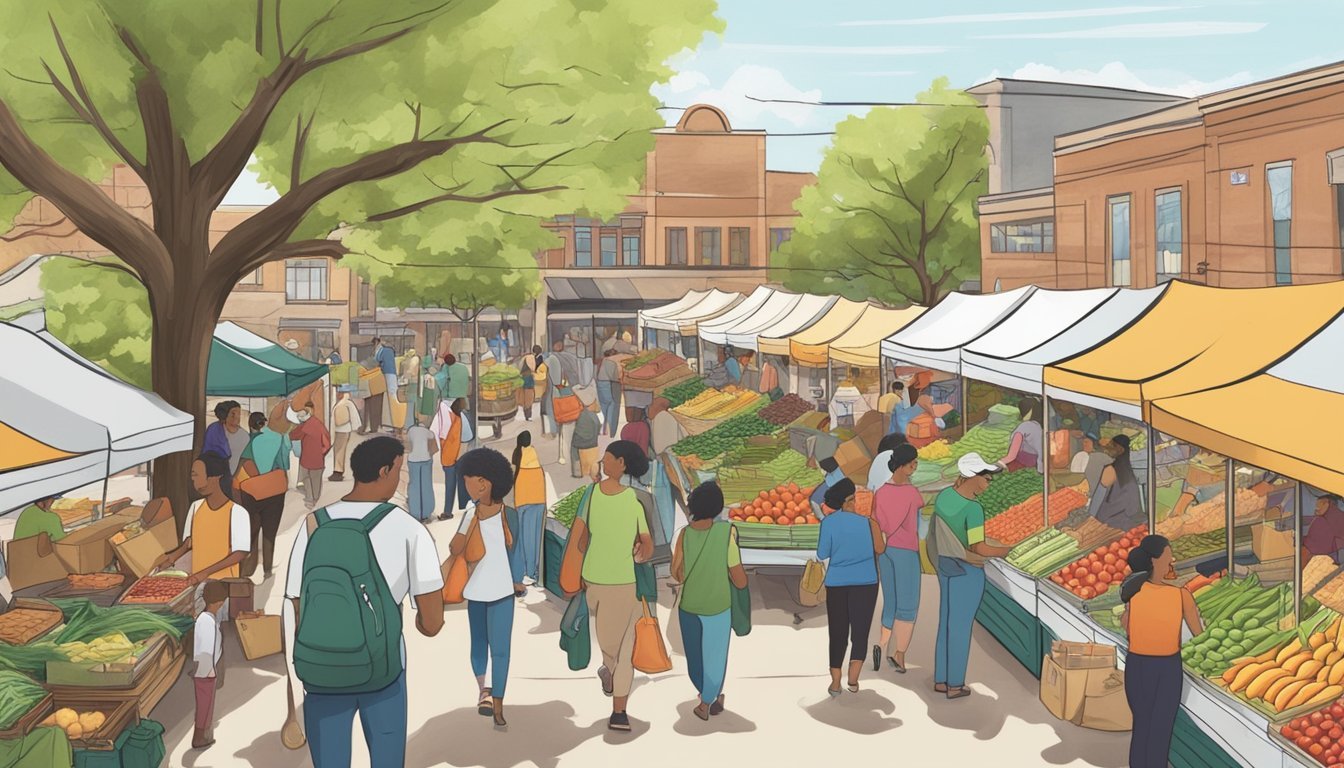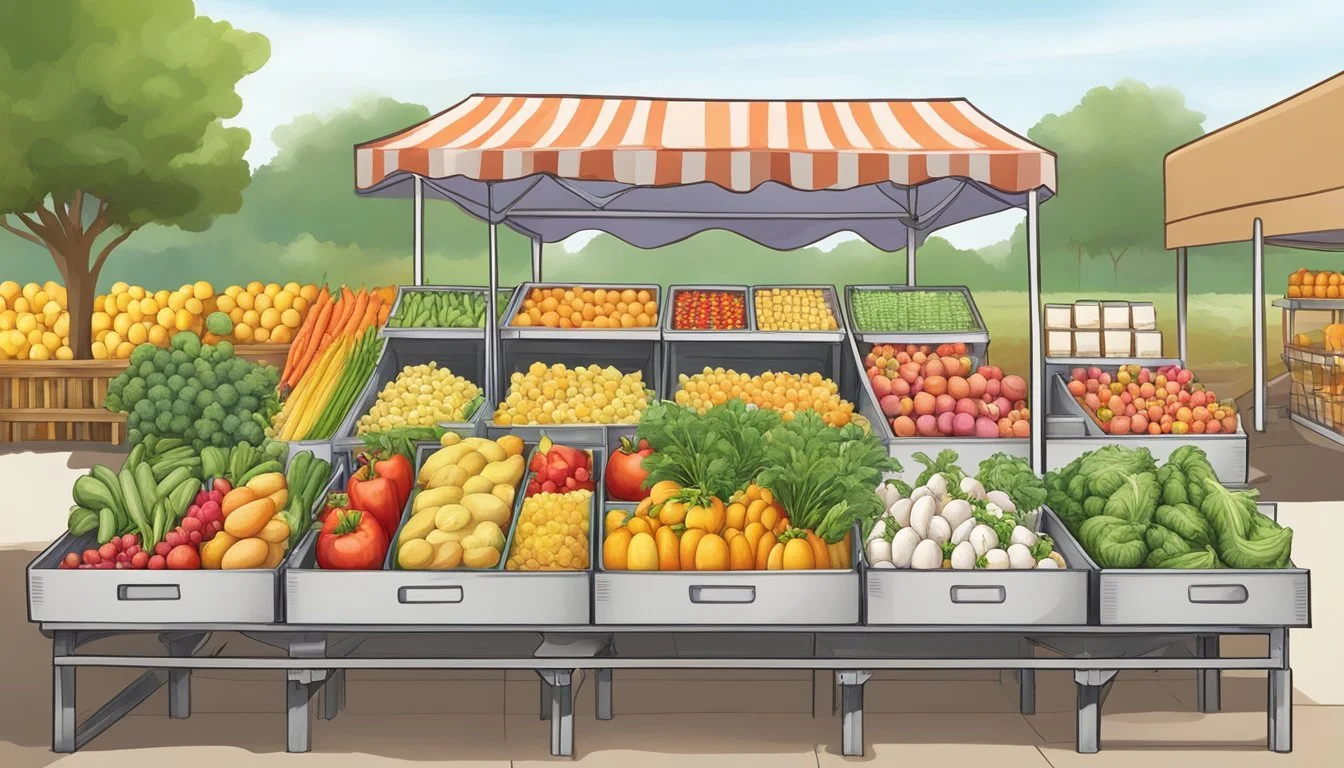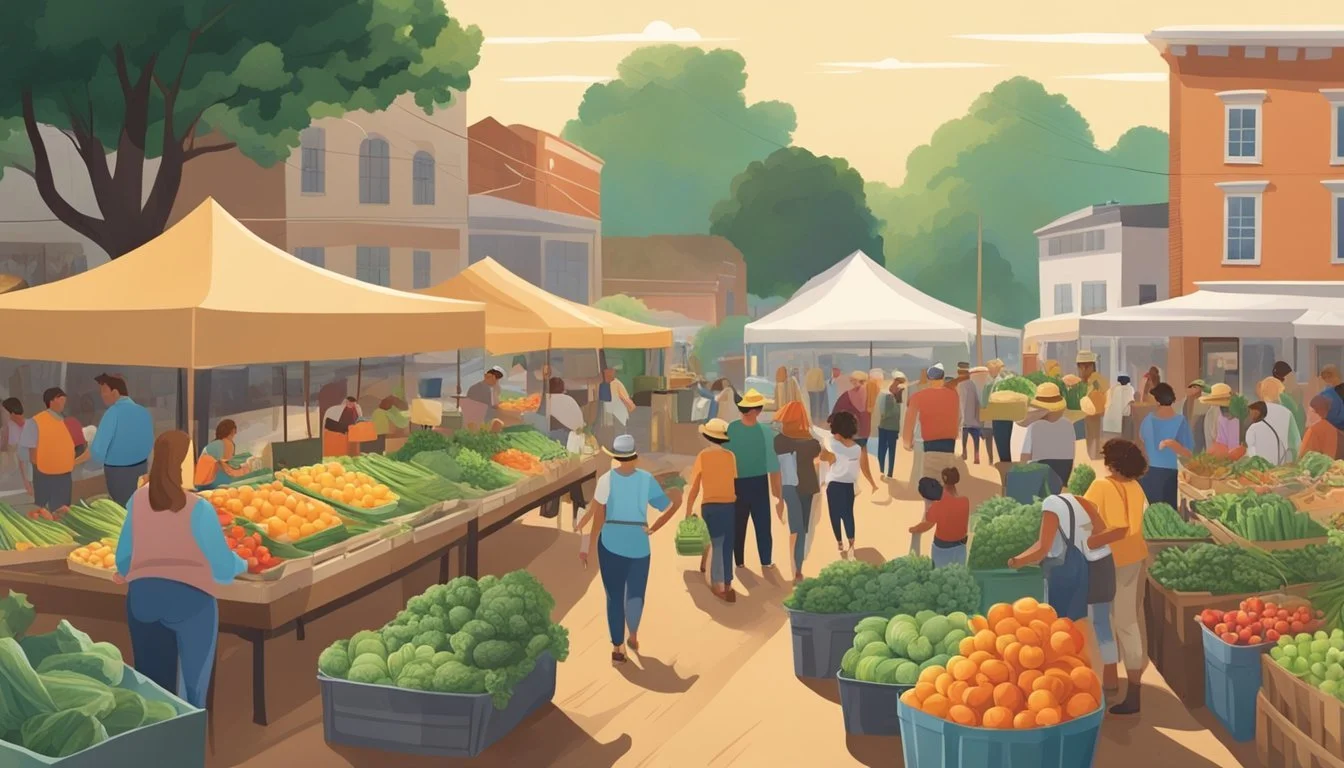Community Supported Agriculture (CSA) in Richardson, TX
Nurturing Local Food Connections
Community Supported Agriculture (CSA) represents a partnership between local consumers and farmers in Richardson, TX, which not only fosters community engagement but also ensures the availability of fresh, local produce. This model of agriculture allows consumers to purchase shares of a farm's harvest in advance, providing them with a regular supply of seasonal produce while offering farmers upfront capital to manage their farm operations. The direct connection between consumers and farmers under the CSA model strengthens the local food system and encourages sustainable farming practices.
In Richardson, Texas, a variety of CSA options are available to community members seeking to involve themselves in this symbiotic relationship. Local farms offer shares that typically include a plethora of vegetables, fruits, and sometimes other products like eggs or honey. CSA subscribers in Richardson enjoy the richness of the harvest throughout the growing season, with the content of their share reflecting the ebb and flow of crops.
The community's embrace of CSAs in Richardson underscores a growing commitment to supporting local agriculture and a desire for transparency in food sourcing. By participating in a CSA, residents are not just customers but active members invested in the cultivation and success of their local farms. This model helps mitigate some of the financial risks farmers face by providing them with a dedicated market, and in turn, participants gain access to the freshest possible produce while contributing to the resilience and sustainability of the local farming community.
The Basics of CSA
The concept of Community Supported Agriculture (CSA) offers a direct bridge between consumers and local farmers, fostering a partnership characterized by shared risks and benefits, with membership models evolving over time.
Defining CSA
Community Supported Agriculture (CSA) refers to a model where consumers purchase shares or memberships in a farm's upcoming harvest. In this symbiotic relationship, consumers are typically provided with a regular supply of fresh, local produce throughout the farming season.
History and Evolution in the U.S.
The CSA model emerged in the United States during the mid-1980s, influenced by European biodynamic farming practices. It was designed to counteract the decline of small-scale agriculture and to support farms directly, thus ensuring the survival of local food sources. The USDA reported 7,244 farms utilizing CSA arrangements as of their 2020 data collection, indicating considerable growth in the acceptance and practice of CSAs.
CSA Membership Models
A typical CSA operates by offering memberships or "shares" to the public:
Standard Share: A box of assorted vegetables delivered weekly or bi-weekly.
Market-style Share: Members choose a specified amount of produce from a wider selection, similar to a market setting.
"U-Pick" Share: Members harvest their own selection directly from the farm.
Advantages of Joining a CSA
Members of a CSA enjoy several benefits including:
Access to fresh, seasonal produce that often boasts higher nutritional value due to reduced time from farm to table.
Cost savings as middlemen, shipping, and processing fees are minimized.
Exposure to a wider variety of crops and the opportunity to learn about sustainable farming practices.
Joining a CSA in Richardson, TX
For residents of Richardson, TX, joining a Community Supported Agriculture (CSA) program offers a means to engage with the local community and obtain fresh, seasonal produce directly from local farms. This section delves into how to locate local CSA offerings, considerations for potential members, and the particulars of the subscription process.
Finding Local CSA Programs
Individuals can find CSA programs in Richardson by exploring local farmers' markets or searching online platforms like TexasRealFood and LocalHarvest, which connect consumers to regional farmers. Additionally, some farms in the area might advertise subscriptions through social media or their own websites, providing an opportunity to learn more about their offerings and farming practices.
What to Consider Before Joining
Prior to subscribing to a CSA, consider the following:
Volume of produce: Determine if the share size is adequate for your household's needs.
Pick-up or delivery: Check if the farm offers convenient pick-up locations or delivery options within Richardson.
Variety of products: Confirm the diversity of produce or other farm products available throughout the season.
Payment plan: Understand the payment structure and any upfront costs required.
Subscription Process
Once a suitable CSA program is identified, the subscription process generally includes:
Completing an application form, which is usually available on the farm's website or at their market stall.
Selecting your preferred share size or type, which could range from small vegetable boxes to larger mixed product shares.
Arranging payments, whether through a single upfront fee or an installment plan, depending on the CSA's policy.
By following these steps, Richardson residents can participate in local CSA programs, thereby fostering a closer connection to their food sources and reinforcing the economic sustainability of their farming community.
Benefits of CSA For Consumers
Community Supported Agriculture in Richardson, TX offers tangible benefits for consumers. From access to fresh produce to environmental stewardship, CSAs enrich the community with various perks.
Fresh and Nutritious Produce
Consumers enjoy fresh produce picked at the peak of ripeness, which is often more nutritious and flavorful than store-bought alternatives. The proximity of local CSA farms to Richardson means produce is harvested and distributed quickly, retaining its nutritional value and taste.
Freshness: Produce is often harvested within 24 hours of pickup or delivery.
Nutritional Content: Less time between harvest and consumption preserves vitamins and minerals.
Supporting Local Agriculture
Participating in a CSA directly supports Richardson's local farmers and the community. Consumers help sustain small farms, keeping money in the local economy and strengthening the region's agricultural base.
Community Impact: Each subscription contributes to the viability of local farms.
Personal Connection: Consumers get to know who grows their food, fostering a sense of community.
Economic Savings
CSA subscribers may save money on groceries. While upfront costs can seem higher, the seasonal abundance and variety of produce often lead to overall savings.
Seasonal Rates: Buying in-season produce through a CSA can be more cost-efficient than supermarket prices.
Bulk Purchase: Paying for several months of produce upfront can reduce the average cost per item.
Environmental Advantages
CSAs have a positive environmental impact by promoting sustainable agriculture and reducing carbon footprint. Minimal transportation requirements mean a significant reduction in greenhouse gas emissions.
Sustainable Practices: Many CSAs follow organic farming practices, which promote soil health and biodiversity.
Reduced Transportation: The local distribution of produce diminishes transportation distances, lowering associated emissions.
CSA Offerings
In Richardson, Texas, CSA programs offer a symbiotic relationship between local farmers and community members, delivering a plethora of fresh produce and farm products across seasons.
Understanding CSA Shares
Communities in Richardson engage with farms through CSA shares, which are essentially seasonal subscriptions. Members pay upfront for a season's worth of produce, financially supporting the farmer during the planting and harvesting months.
Typical Contents of CSA Shares
CSA shares typically brim with an assortment of fruits and vegetables. Subscribers might expect leafy greens, root vegetables, tomatoes, and peppers, among other produce, depending on the harvest.
Seasonal Variety in CSA Shares
Seasonal variety is a staple of CSA offerings. Collaborating farms rotate their box contents to match the growing seasons in Texas, ensuring shareholders receive the freshest produce:
Spring: asparagus, strawberries
Summer: watermelons, peaches
Fall: squash, apples
Winter: citrus, leafy greens
Non-Produce Items in CSA Shares
Beyond produce, many CSAs incorporate other farm products. These can include:
Eggs: Often free-range and available based on flock production
Meat: A variety of cuts from pasture-raised animals
Cheese: Small-batch artisanal varieties
Flowers: Locally grown, adding vibrancy to a share
The inclusion of these items introduces shareholders to a wider range of local farm offerings, enhancing the CSA experience.
For Farmers and Producers
In the Richardson, TX area, CSA models offer tangible perks and pose unique challenges for farmers and producers, emphasizing the importance of strong customer relationships and effective marketing strategies.
Benefits to Farmers
Farmers gain several benefits from CSA programs, including financial security with upfront payments, which aids in early season capital. They also benefit from a guaranteed market for their produce, reducing the risks of overproduction or unsold inventory. Moreover, CSA allows for closer farmer-consumer connections, fostering loyalty and repeat business.
Financial Security: Pre-season revenue through share subscriptions
Guaranteed Market: A consistent customer base for products
Challenges for CSA Farmers
However, CSA farmers face challenges like managing the logistics of distribution and ensuring a diverse offering each week to satisfy customers. They must also deal with the unpredictability of agricultural yields, which can affect the quantity and quality of deliverables.
Logistics: Coordinating pickup locations and delivery schedules
Crop Diversity: Maintaining an attractive assortment of produce throughout the season
Fostering Customer Relationships
Building strong relationships with customers is pivotal; farmers must maintain transparency regarding farming practices and crop availability. CSA programs strengthen the local agriculture community by creating partnerships and a sense of involvement among customers, who feel more connected to the food they consume and the individuals who grow it.
Transparency: Open communication about farm operations and potential issues
Community Connections: Engaging customers through farm visits, newsletters, and social media
Marketing and Sales Strategies
For marketing and sales, creating appealing CSA packages and using effective promotional tactics are key. Farmers should consider leveraging online platforms for sales and engaging in local events to increase visibility. Establishing online presences, like social media profiles and websites, helps to reach a broader audience.
Appealing Packages: Offering various share sizes and options to attract different customer segments
Promotion: Utilizing digital and community-based marketing to boost sales
Through these strategies, CSA farmers in Richardson can enhance their operations and contribute significantly to the local agriculture economy.
Seasonality and CSA Operation
Community Supported Agriculture in Richardson, Texas adapts agricultural activities to the state's dynamic growing seasons and weather patterns to ensure a successful harvest.
Growing Seasons in Texas
Texas features multiple growing seasons throughout the year, with specific planting and harvesting times depending on the crop. In Richardson, CSA operations leverage the spring to early summer period from March to June for early season crops, and the main growing season that typically runs until August. Fall crops are usually planted in late summer to harvest before the first frost.
Weather Considerations
The weather in Texas can be unpredictable, ranging from dry, hot spells to sudden, heavy downpours that can affect crop viability. CSA operations must stay vigilant and incorporate adaptive practices like irrigation during droughts or protective measures against storm damage to safeguard their yields.
Planning for Seasonal Shifts
Successful CSA operations involve meticulous planning to accommodate Texas's seasonal shifts. This includes:
Crop Rotation: alternating crops each season to optimize soil health and manage pests.
Cover Crops: planting out-of-season cover crops to enhance soil quality and prevent erosion during off-peak times.
Greenhouses: utilizing greenhouses for certain crops to extend growing seasons and protect against weather extremes.
By optimizing these strategies, CSA in Richardson can thrive despite the seasonal and weather challenges inherent to Texas.
Community Involvement
Community Supported Agriculture (CSA) programs in Richardson, TX are not simply about the exchange of produce for payment; they are a foundation for fostering strong community ties through shared support and educational growth.
Building a Sense of Community
CSA programs in Richardson offer more than weekly baskets of food; they serve as a platform for residents to form enduring connections. Each subscription goes beyond the dining table, weaving individuals into the fabric of local agriculture. Members often share recipes, stories, and even the harvest itself, cultivating a local network rooted in mutual support for sustainable practices.
Educational Events and Workshops
Richardson CSA programs host events and workshops aimed at engaging members and non-members alike. They typically cover topics such as:
Sustainable Farming Techniques: Educating on eco-friendly practices
Cooking Classes: Demonstrating how to prepare seasonal produce
Gardening Tips: Sharing knowledge to encourage home gardening
These events serve dual purposes: enhancing the community's understanding of agriculture and reinforcing the bond between consumers and their food sources.
CSA and Local Partnerships
Partnerships are a cornerstone of CSA programs in Richardson, with many local businesses and organizations collaborating to support and expand their reach. These partnerships often include:
Local Markets: Promoting CSA shares and hosting pickup locations
Schools: Involving students in food education
Nonprofits: Joining forces to address food insecurity
Through these collaborations, Richardson's CSA initiatives enhance their contribution to the local community, bridging the gap between rural agriculture and urban consumers.
Tips for CSA Members
Choosing a CSA (Community Supported Agriculture) program is an essential step for Richardson, TX residents who value fresh, local produce. Members should consider how to utilize their shares effectively, embrace the variety of new vegetables, and understand the best practices for storing and preserving their weekly bounty.
Getting the Most Out of Your Share
When one becomes a CSA member, planning is crucial. Members should review what will be available in their upcoming share so they can meal plan accordingly. Utilizing the entire box each week minimizes waste and encourages a varied diet. It also helps to know the pick-up location and time to ensure freshness.
Estimate consumption: Assess how much produce your household consumes to select the appropriate share size.
Meal prep: Base your meals for the week around the CSA contents to integrate all the provided ingredients into your diet.
Exploring New Vegetables and Recipes
One of the joys of a CSA membership includes the introduction to new vegetables that one might not typically purchase. Members should see this as an opportunity to expand their cooking repertoire.
Research: Look up recipes in advance for unfamiliar items.
Experiment: Don't be afraid to try new cooking methods like roasting, sautéing, or grilling to enhance flavors.
Proper Storage and Preservation
Proper storage extends the life of CSA vegetables and fruits, ensuring members get the most out of their share. Each type of produce has its own storage needs, and members can take simple steps to preserve their freshness.
Vegetable Type Storage Method Leafy Greens Refrigerate in airtight bags with a damp cloth Root Vegetables Store in a cool, dark place; preferably not refrigerated Berries Keep in a container lined with paper towels; refrigerate
Labeling: Date produce when storing to keep track of freshness.
Preservation: Consider preserving excess produce through canning or freezing.
Sustainability and Future Outlook
Community Supported Agriculture (CSA) in Richardson, Texas, is an influential model promoting sustainable agriculture and reducing carbon footprints through minimized packaging. While the practice garners support, its projection into the U.S. agricultural future remains an evolving subject.
Role in Sustainable Agriculture
CSA programs directly support sustainable agriculture by providing local farmers with a reliable income source and allowing consumers to invest in organic farming practices. These practices, endorsed by the U.S. Department of Agriculture, often result in a range of ecological benefits including increased biodiversity and soil health. With consumers invested in the farming process, there is also a surge in transparency and trust in food production.
Reducing Carbon Footprint and Packaging
The localized distribution model of CSA substantially reduces the carbon footprint associated with food transport. In Richardson, Texas, this model translates to fewer food miles as produce does not travel long distances from farm to consumer. Additionally, CSA often uses less packaging or opts for eco-friendly packaging solutions, further mitigating the environmental impact.
Key Statistics:
Food Miles: CSA can reduce food transport by up to 75% compared to conventional methods.
Packaging: CSA programs have demonstrated a reduction in packaging waste by using reusable and recyclable materials.
Future of CSA in the U.S.
The future of CSA in the United States points towards growth with a dual focus on sustainability and community engagement. The rising consumer demand for local, organic produce suggests more farms could adopt the CSA model. This shift could bolster economic sustainability for small farms while contributing to a robust and resilient local food system. The U.S. Department of Agriculture continues to monitor the impact and spread of CSA farms, which may lead to increased support and potentially favorable policies.
Projected Trends:
Economic Impact: Enhanced economic stability for small to medium-sized local farms.
Consumer Demand: Growing interest in locally sourced, organic produce likely to increase CSA memberships.










